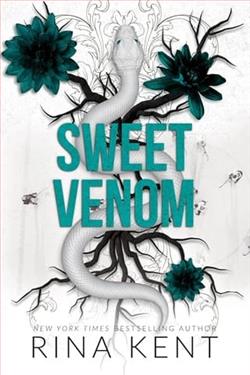Page 2 of Crystal Iris
Aaron would sneak in after school on most days. We’d watch TV, do our homework, and, of course, make out until it was dinner time and we both had to show our faces to our families. My grandparents were too old to go upstairs; they mostly stayed on the first floor until bedtime, giving me almost full rein of the upper level of the house during the day. That, along with the constant sound of their loud TV, allowed me to grow up faster than most kids my age. Mostly, though, Aaron was there for me—when the anxiety attacks would creep in, when my breathing would get stuck. He was there to rub my back, guiding each inhale and exhale for as long as I needed. He was there when I cried on my birthdays, on Christmas, even at prom. He was the first one I showed my college admission letter to, and even though we went to different schools, we stayed tight.
Turns out, it’s very easy to date your best friend. And then keep dating him,because he loves you.
I plan to do my research right away since I don’t have any papers to grade this morning. After such busy weeks, I welcome the break. If any place has abundant information on prisms, it has to be Harvard’s library. I understood nothing from the descriptions I found online. Words like “polyhedron,” “base,” “second base,” and “faces” kept popping up. Although I got the gist—a glass geometric object used to spread out light—what I need to know is:what the heck was that violet light I saw yesterday in the tub?I haven’t seen it again since. I stared at it in the mirror this morning, hoping it would happen again, like somehow I could turn it on. Now it’s merely a beautiful piece of jewelry. I’m starting to wonder if I made the whole thing up.
The library is framed by beautiful large windows on both sides, with a dome ceiling that mimics classical temples. I’m used to getting lost in the maze, but I don’t think I’ve ever made it to this section before—rows and rows of books I have no idea how anyone understands.
I don’t ask for help; I don’t want to draw attention to myself. I want to avoid the noisy students and the faculty who love to gossip. Does anyone have hobbies anymore? Like, the only reason to be researching anything should be because you’re writing a damn paper. What happened to learning for enjoyment?
I fell in love with art history when I was a little girl. Mom, Dad, and I would spend our Sunday mornings at the art museum, like a religious appointment. Dad came because we loved it; I knew it wasn’t his passion that brought him there. I remember how my mom could simply stare at something for hours, not realizing that Dad and I were waiting for her to keep moving along. She had an apologetic smile when she’d break the trance and find us looking at her.
After she got sick, Dad kept bringing me. I told him he didn’t have to, but he reassured me that he liked it. I knew he did it for her. And after he left me—I was thirteen—I kept the habit. I would find myself there, even when I lied and pretendedI was only going to the park. It was my home away from home, a place where I could still feel my parents nearby, happy. Dad and I would make up stories about who the people in the paintings were; sometimes, I imagined I was part of their life too. Especially when everything fell apart. I wanted to escape to those meadows, talk to those people, ask them to take me away.
When senior year came around, I knew the only thing I could imagine myself doing was studying those paintings. Aaron had asked me a few times if I wanted to paint, but I never had the desire. I wanted to understand the hand that created those paintings. I wanted to know what made someone take their time—often a long time—to create such things. What drove them, what pushed them, what fed them. I wanted to know the story behind each artwork, the real story. I became obsessed in college. I didn’t have the ambition to become a professor; it was pure passion that led me to rise to the top of my classes.
“Professor De Loughery?” A voice breaks my blank stare.
“Hey, Darion, remember, Iris is just fine.”
He’s staring at his foot, a little uncomfortable with my directness. Darion is a little taller than me, with dark eyes that hide behind his glasses.
“What are you doing on this side of the building? I hope you’re not thinking about changing majors,” I ask.
“Just helping a friend.”
If I didn’t know better, I would say he was probably getting paid to do someone else’s work.
“How nice of you,” I say.
“What about you?” he asks, giving me an odd look.
“Personal project.” Before he can say anything else, I start to walk away. “See you in class.”
I gather more books about math than anyone could read in a lifetime. I scan the pages, but nothing explains what I saw in the bathtub last night. I do end up learning an interesting fact: apparently, prisms have been used as early as the thirteenth century togenerate rainbows. Sunlight looks white to our eyes, although it’s actually a mixture of many colors. A prism can be used to refract or disperse a beam of light, separating those colors. Still, you are supposed to see all seven of them, not just one. I’m startled by my phone buzzing—the alarm reminding me that I’m needed in the classroom.
“Is she pregnant?” Stella asks, a young blonde with a huge canvas bag who always sits in the corner. An artist herself, judging by the spilling contents.
I glance back at Jan van Eyck’s iconic portrait ofGiovanni Arnolfini and His Wife, one of my favorite pieces of art.
“That’s a common question, Stella,” I say. “Most historians agree she isn’t. She’s simply holding her large skirts. Young Renaissance women were also encouraged to clasp their hands like that. It was a sign of modesty. The subject of pregnancy is still debatable. Take a look here, at the bed’s headboard… This is a wooden statue of Saint Margaret, the patron saint of childbirth. And let’s look over here as well, at the window: another symbol, ripened fruit. Everything signals that, if she isn’t pregnant—which artists typically avoided depicting, as it was considered improper—she is expected to be soon. What else is her gown telling us?”
“That she is wealthy,” Ava says, typing quickly on her laptop.
“Correct. Her ermine-lined gown is proof of her husband’s wealth. What else indicates that?”
“The brass chandelier and the oriental carpet,” Darion says, still giving me a weird look.
“And the mirror,” Stella adds, writing something down.
“Let’s take a closer look at the mirror,” I say, zooming in on the painting. “We see someone else there, wearing red—that is the artist himself. This mirror has enough details to warrant an entire lecture. I’ll be brief now, but we’ll discuss it in more depth nextweek. Around the mirror’s wooden frame, we see scenes from the Passion of Christ—it might represent the premise of salvation, or God observing the vows of the wedding. Some believe this painting represents that: matrimony.”
“What’s with the dog?” Isaac asks.
“The little terrier could symbolize either fidelity or lust, or perhaps a desire for children. It might also be a gift from the husband to his wife. It also reflects the couple’s wealth and their position in court. We’ll revisit this painting next week. Now, let’s hear how the assignment went,” I say, closing the image.
“I thought I was going to lose my mind. The time did not pass,” Stella says.
“I thought it was relaxing,” says Paul, trying a little too hard to be agreeable. I see most of the students roll their eyes.















